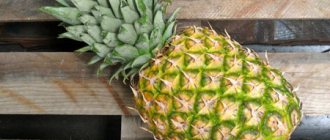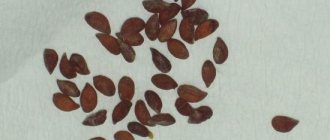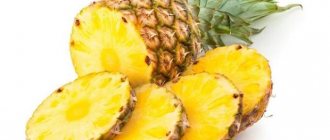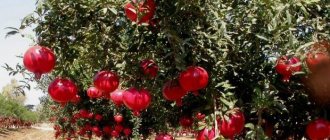In Latin America, where pineapples grow wild, there are eight species of this perennial herb. Only one of them, the large-tufted pineapple (Ananas comosus), has been adapted for growing at home. Its varieties will not be particularly diverse, although they differ from each other in foliage color: from light green to whitish with a border or stripes that gradually acquire a pink tint.
Home care
If you give a pineapple everything it loves - a lot of warmth and light - it will delight its owners with rapid growth, flowering and even fruiting. You can buy the plant at a flower shop or try to grow it yourself. In any case, your task is to provide the South American guest with appropriate conditions of detention.
Location and lighting
It is advisable to place a pot of pineapple on a south window. Let him enjoy the sunshine without restrictions. Unless on some too hot days you will have to shade it slightly. As a last resort, place the flowerpot on the southwest windowsill.
If you place it in another place, you will have to illuminate it with a phytolamp for up to 12 hours of daylight. The evergreen beauty will not be able to develop on artificial lighting alone. Still, he will need natural light, so as soon as you notice that your pet’s leaves have begun to turn pale, combine natural and artificial lighting. And don’t forget to rotate the tub from time to time so that the outlet receives light evenly.
Temperature
This heat-loving representative of the Bromeliad family will not forgive you for temperatures dropping below 16 degrees in winter. There is no need to specially take the pot out into the cool place. Pineapple will tolerate +20-22°C just fine. And in the summer, the warmer it is, the better. The ideal temperature is +25°C. But the plant will calmly survive the increase in degrees.
On particularly hot days, you can take the tub out onto the balcony or into the yard. Just choose a cozy place where the draft will not reach. And indoors, make sure that the cold wind from the window does not blow towards the leaves.
Watering
In winter, water the pineapple not very often, as the soil dries out. But when the bush is in a state of flowering or fruiting, moisture saturation should be increased. Soft and warm (30-35 degrees) water can be poured directly into the outlet.
Do not allow water to stagnate in the pot, otherwise the root system may rot, but the soil should be constantly moist. When September comes, gradually wean your green friend from frequent watering, preparing for the dormant season.
Air humidity
There should be a humid microclimate around the pineapple. During the warm season, constantly practice spraying the leaves. In winter this is not necessary. Unless the humidity in the room is too low. The pet tolerates showers well.
The soil
Select acidic and loose soil for pineapple. To get the optimal substrate, mix:
- 25% humus;
- 30% turf;
- 15% coarse sand;
- 30% crushed peat.
In such proportions the soil will be permeable.
Feeding and fertilizers
In the autumn-winter period, the green ward does not need feeding, as it is in a state of rest. And from spring to autumn you will have to feed it twice a month.
You can use complex fertilizers or alternate mineral fertilizing with organic fertilizing. It is recommended to use mullein from organic matter. Fill a liter jar one-third full with fertilizer, top up with water. Stir regularly, and after 10 days the solution is ready. Dilute it in a bucket of water and you can feed the pineapple.
When the plant loses color, use mineral complexes. When fruits appear, practice watering with sweet water (2 tablespoons of sugar per 20 ml of water).
Do not use ash or fertilizers with lime under any circumstances.
Transfer
After bringing a pineapple sprout from the store, immediately begin replanting. To start, take a 3-liter pot. It should be wide enough and not too deep, since the roots are located close to the surface.
Line the bottom of the flowerpot with drainage, sprinkle with soil mixture or purchased soil for citrus fruits. Move the plant along with the earthen lump into a new container and add as much earth as needed. If you do everything correctly, the pineapple will respond with the appearance of young shoots.
Make the second transplant six months later, and the third one a year after the growing season. Next, watch the roots. As soon as they feel crowded, move the bush into a tub with a wider diameter. It is best to carry out the procedure in March. Each time during transplantation, deepen the root by 1-2 cm.
Wear protective gloves as the pineapple has quite sharp spines.
Trimming
The bush does not need any special pruning. Only dry or damaged leaves should be removed. At the same time, grab part of the healthy leaf adjacent to the sore spot. Disinfect the knife for work.
Common indoor species
Three types of pineapple can be successfully grown at home.
Large tufted pineapple (A. Comosus) , which is characterized by good fruiting. The leaves are green, very long, narrow, with thorns along the edge.
There is also a variant of A.comosus Variegatus. It has shorter leaves with variegated patterns and pink-red fruit. This pineapple hybrid is grown at home mainly for decorative purposes.
In recent years, Dutch growers have developed a dwarf variety specifically for indoor cultivation - Ananas nanus or Dwarf - a delicious little pineapple, which is only 30-40 cm tall. The small pink inflorescence subsequently produces small edible fruits.
Ananas nanus
The leaves are long, hard, dark green or glaucous, turning dark burgundy in the sun. The height of the dwarf variety "Champaca" is approximately 35 cm (including pot).
Pineapple bract (A. Bracteatus) , namely its variation A. Bracteatus tricolor. Characterized by tall growth, long, belt-like green leaves with bright longitudinal stripes in red, pink, white or cream.
The edges of the leaf blade are jagged or smooth. The spectacular bright red fruits are edible, but not very tasty, so this species attracts gardeners for its decorative qualities.
A. Bracteatus tricolor variety "Striatus"
All potted varieties are widely available in flower departments.
Flowering and fruiting
Usually 2-4 years after the rosette is formed, the pineapple produces a peduncle. If this does not happen, the plant can be “helped” to bloom. This is done in different ways:
- Feed with liquid organic matter throughout the growing season at intervals of 14 days;
- for 5-7 days, pour into the outlet a solution of 15 g of carbide diluted in 1 liter of water;
- cover the pineapple with a bag and place a piece of smoking carbide next to the flowerpot;
- Place overripe apples nearby on the windowsill and do not remove them for several days;
- fumigate with cigarette smoke once a week for 21 days.
After such procedures, in about 2-3 months an inflorescence should appear, and after a month the ovary should appear. After six months, you will be able to enjoy the ripe fruit.
Pineapple blooms with blue flowers. The process will take two weeks, accompanied by a pleasant aroma. Each of the flowers fades as the day passes. After the last one has faded, the fruit begins to form.
The ripening of the fruit marks the death of the plant. This doesn't happen right away. The pineapple still has time to produce young shoots that can be used for replanting.
Pineapple varieties for home cultivation
There are many varieties and varieties of tropical crops, but only a few are grown as indoor pineapple:
- True, crested or large-tufted. It is a herbaceous plant with hard typical or bromeliad leaves that form a dense rosette. The variety is large in size, but quite unpretentious and grows quietly in a shaded place.
- Bractose. It is highly decorative. Its leaves are curved and reach a length of up to half a meter. The surface shade of the plates is green, cream and pink.
- Dwarf. The leaves of this pineapple grow up to 25 centimeters. The culture feels great even with slight shading. In the sun, the leaves of the miniature plant acquire a reddish color. It produces small fruits (diameter 5 cm) that are edible.
These varieties are distinguished by high decorative properties. Not all gardeners are interested only in the external characteristics of the crop. If homemade pineapple is grown to produce tasty and juicy fruits, you should choose varieties of the large-tufted variety, among which the following are especially popular:
- “Red Spanish”, which is prickly, but quite resistant to the development of various ailments;
- "sugarloaf", which has quite sweet fruits.
Articles about garden plants.
Finding a suitable variety is not always possible. An alternative option would be to purchase a tropical fruit, from which an adult specimen is then grown:
- Cotton can be easily separated even without the use of any tools. It is extracted from a tropical fruit. If this cannot be done, use a knife and cut off this part with the pulp (3-4 centimeters)
- Three rows of lower leaves are removed to obtain a small stump, which is dried in a vertical position or hung. The crest is placed in a ventilated, shaded, warm place.
It takes from three to four days until it dries. Next, the tuft is planted in moist soil, waiting for rooting for two months.
Pineapple for home
Reproduction
Exotics can be propagated in three ways:
- seeds;
- apical cutting;
- daughter sockets.
All of them are effectively used at home with consistently positive results.
Seeds
You won't get seeds from pineapples bought at the supermarket. Therefore, you will have to buy them at a flower shop. Before planting, keep the seed for a day in a warm place, placing it between two wet wipes. The seeds should swell. Now they can be planted in a peat-sand mixture, planting 1-2 cm deep. Cover the top of the box with glass or stretch the film to create a greenhouse. Place in a warm place. In cool weather, the seeds may not hatch.
The first sprouts will have to wait from 3-4 weeks to 1.5 months. If the air temperature is above 30 degrees, germination will begin in the second or third week.
Moisten the soil all the time. Once every 15 days, feed the seedlings with complex fertilizers.
When rosettes with 4-5 leaves are formed, plant them together with a lump of earth in a regular soil mixture, adding a little crushed charcoal. Then grow them as mature plants.
Top
To do this, you need to buy ripe fruit in the store. Choose ones with firm green leaves. If they wilt or become lighter in color, the pineapple will not germinate. It is also impossible to get a new plant from frozen fruit, which is usually sold in winter.
Unripe fruit can be identified by tearing out one leaf. If this is difficult to do, it means it is not yet ripe.
Make sure the crust is an even golden brown color. Do not take green or stained ones.
When you get home, cut out the top (sultan) with a small amount of pulp. You can simply scroll the tops, disconnecting them from the base. Cut the lower leaves so that the stem is exposed by 2-3 cm. Treat the cut areas with a solution of potassium permanganate. Let the seedling dry for 2-3 days, keeping it hanging upside down. You can store it for up to a week, but no more.
Then plant it in wet sand, covering it with a cap cut from a plastic bottle. Keep the sprout in a warm place and moisten regularly. The roots should appear in about 3-4 weeks.
The second method of germination is in a glass of water. Just make sure that the leaves do not touch its level. Change the water from time to time.
When the roots reach 5-6 cm, they can be transplanted into the soil. The pot must be at least 15 cm in height. Cover the stem with roots with soil and leave the leaves outside. Keep the soil moist. The room should have enough light and warmth.
First, young leaves will appear in the rosette, and the old ones will gradually dry out and will have to be cut off. From now on, try to always have water in the formed funnel.
After about six months, a red cone should appear in the center, from which blue petals will subsequently form, and then a fruit will form.
Basal rosettes
During transplantation, separate the formed children from the roots. They can be broken off or cut from a mature plant. It is desirable that these basal rosettes gain 15 cm in height and have a formed rosette with several leaves. Sprinkle the cut area with crushed coal. Place the children in a container with a sand-peat mixture, covering it with film.
Questions and answers
- Why doesn't pineapple bloom at home?
Often an exotic crop develops well and is absolutely healthy, but flowering does not occur. When this happens, it is necessary to stimulate this process. Place a teaspoon of calcium carbide in a half-liter jar and thoroughly dissolve it, then leave for a day. The liquid is drained from the sediment, and then 50 ml is poured daily into the center of the outlet. After 30-45 days the culture begins to bloom.
- Why does mold form on the walls of the pot in an indoor pineapple?
This happens due to excessive watering in winter. To get rid of mold, you need to reduce the frequency of watering. It is removed using a paper napkin.
- What to do when the leaves start to dry out?
Drying of an indoor pineapple occurs if it is in a too hot place or is in direct sunlight. The situation can be corrected by moving the flowerpot to a cool place and spraying it. On the other hand, a leaf blade that is dead means that the plant is too dark and needs more light.
Diseases and pests
Pests usually avoid pineapple. But sometimes attacks from mealybugs or mites occur. In these cases, use special chemicals on the leaves and rinse them with water.
If a fungus grows inside the rosette, the leaves will turn black and begin to fall off. Apply the fungicide solution by pouring it directly into the core. When the cured plant produces a new leaf, the old and affected ones can be cut off.
Characteristics of the plant and its photo
- Species: crested pineapple, bracted pineapple.
- Flower and fruit color: shades of brown.
- Leaf color: shades of green.
- Requirement for sun: light-loving.
- Size: 50-80 cm in length.
- Flowering: from May to July.
- Aroma: delicate, fruity freshness.
Next you can look at the photo of the plant:
Indoor pineapple grows well at home and produces tasty fruits if you constantly care for it and properly care for it.
Care errors
In addition to pests, pineapple can wither due to improper care. Therefore, take appropriate measures in time:
- If the tips of the leaves dry out, increase the humidity in the room.
- Mold has appeared on the soil - remove it with a napkin and significantly increase the intervals between waterings.
- Light spots on the leaves - treat the leaves with a weak solution of potassium permanganate.
- If the roots are rotten, cut off the bottom of the trunk, leaving only healthy tissue, and re-root the top. In the future, do not keep the pineapple pot in too cool conditions.
- Slow growth - move the flowerpot to a warmer place and water with slightly warmed water.
Where does pineapple come from?
Pineapple is a perennial herbaceous plant, an epiphyte, with compacted, fleshy leaves collected in one strong, thick knot called a basal rosette. This rosette forms a massive stem with a peduncle at the top. The peduncle is usually formed high, up to 50 cm, with a spike-shaped inflorescence and a rosette with a bract.
Pineapple has a very exotic look and looks great in a pot.
Pineapple comes from Brazil, although this plant is cultivated in many countries with similar climates.
In countries with tropical climates, pineapple is grown on an industrial scale
It appeared in Russia under Catherine II and was grown in public greenhouses.
In the wild, the pineapple is accustomed to bright sun, a humid atmosphere and light soil; approximately the same conditions will have to be created on your windowsill for favorable maintenance of this crop as a houseplant.
Varieties
- The pineapple variety "Caenna" is perfect for keeping at home. The most ancient type of pineapple, popular in the tropics, loved by many for its wonderful taste. The weight of a mature fruit can be about 600 grams.
- The pineapple variety " Champacca" is often grown as an ornamental plant. Champaka looks truly picturesque, like most bromeliads: sharp saw-toothed leaves springing elastically from a single rosette and ripe golden fruits with conical inflorescences of pink shades.
- Decorative pineapples (Ananas Nanas) are very popular among gardening and landscape design lovers because they have a colorful appearance and look very colorful among other plants. Decorative varieties of pineapples stand out not only for their bright bracts, but also for their variegated foliage and red shades.
- The Mauritius pineapple variety tolerates transportation well and is therefore often grown commercially. In addition, Mauritius has good taste and is also quite suitable for home cultivation.
- Pineapple variety MD-2 is a pineapple hybrid developed by a Hawaiian research institute through a crop breeding program. It is an international standard of quality among market products. The resulting hybrid took root and spread throughout the world. The fruits of MD-2 are very sweet, bright golden in color with a low degree of acidity. The variety is resistant to parasites and internal putrefactive processes.
Photo gallery: pineapple also comes in different varieties
Pineapple variety MD-2
Decorative variety of pineapple, large-tufted
Pineapple variety Champaka Pineapple variety Mauritius
Cayenne pineapple variety
Video: growing pineapples in captivity
Table: seasonal maintenance of the plant
| Summer | Winter | |
| Temperature | 18°С-25°С | 18°С-20°С |
| Watering | abundant | moderate |
| Feeding | 2 times a month | No |
| Air humidity | spraying | No |
| Lighting | intense | No |
Rules for choosing a plant for planting
A pineapple planted at home in a pot, a photo of which can be found in this article, requires constant care, and if this is not done, the plant will not bear fruit. Particular attention should be paid to the choice of planting material.
First of all, you should carefully examine the fruit that is selected for planting. Its bright yellow-brown hue will indicate that the pineapple is ripe. If the skin on the fruit is hard, then it is not yet ripe and is not suitable for planting. If, when you press on the fruit, you can immediately feel its softness, then the plant, on the contrary, is overripe. This pineapple is also not suitable for growing.
Sometimes you can find information that the fruit will ripen calmly at home if you put it in a bag of apples for several days or hold it upside down. But in reality this is not entirely true. If you use similar methods to ripen the fruit, its pulp will become much sweeter, as the starch will gradually turn into sugars and be distributed throughout the pineapple. But at the same time, the rosette, which is necessary to grow a pineapple in a pot, will gradually begin to die off.
Also, when choosing a pineapple, you should pay attention to its leaves. They should not only be green and juicy, but also whole (although the edges may still be a little dry). If the plant has gray spots, then it should not be taken for planting. After all, it is precisely such spots that indicate that the fruit is affected by worms. But if there is a small sprout in the outlet, then, accordingly, it will be an excellent guarantee that a pineapple in a pot can grow from such planting material at home. The photo below just confirms this.
When choosing a pineapple for planting, another main consideration should be the smell. When purchasing, you need to smell the base of the plant. A sour smell will mean the pineapple is overripe. And those plants that are suitable for planting should have a sweetish aroma.
To grow a pineapple in a pot, the photo of which will surprise all your friends and family, you should buy it in spring or summer. To increase your chances, it is better to buy two pineapples, but in different stores. It is worth rooting each of them correctly to be sure that at least one will germinate.
Basics of caring for indoor pineapple
The basis for caring for this capricious crop is watering and fertilizing. Pineapple can easily tolerate a slight drying out of the earthen clod. Water the plant only with warm water. This is the basic rule for watering pineapple in winter and summer.
The water must be settled and softened for a long time. It is useful to add a little citric or oxalic acid to the water for irrigation to acidify it.
When watering, it is necessary to fill the rosette of leaves with water. It is especially important to follow this rule if the room is hot and dry. In this case, between waterings the soil in the flowerpot should have time to dry out a little. The water from the outlet should be removed from time to time so that it does not stagnate.
The plant grows a powerful green mass and needs a lot of nutrients for growth. Feed indoor pineapple twice a month, focusing on fertilizers with a high nitrogen content. Nitrogen is especially important in spring. You can purchase special fertilizers for bromeliads or feed them with organic matter.
An excellent fertilizer for indoor pineapple is mullein infusion. Slurry contains a lot of nitrogen, as well as other nutrients necessary for rapid growth and proper development.
What to do if the pineapple does not bloom
Even with good care, pineapple often does not bloom indoors. Therefore, flower growers stimulate flowering in various ways.
You need to purchase carbide at a hardware store. The piece should be the size of a matchbox. The carbide is thrown into a jar of water, and after the end of the violent chemical reaction, the solution is poured into the pineapple outlet, but only 1 tbsp. l.. every other day all these manipulations are repeated.
You can try to stimulate pineapple flowering by smoking. The plant is covered with a bag, and then cigarette smoke is blown under the bag, a smoldering splinter is placed, etc. So they fumigate the plant a couple of times every week.
You can also place a ripe apple next to the pineapple and tightly cover the fruit and plant with a bag. This continues for a couple of weeks, and, as a rule, the pineapple blooms.
In indoor conditions, pineapple rarely gets sick and is practically not affected by pests. If insects are detected, the plant should be sprayed with an insecticide.
Often, most of the problems that a gardener encounters are caused by improper maintenance of the plant - the room may be too cold, the air may be excessively dry. Also, the pineapple may not bloom or even begin to hurt if it does not have enough light.
How to plant pineapple correctly
Surely every second person who has ever bought a pineapple at the market has thought about whether it is possible to grow this crop at home. This is possible despite the fact that pineapple is used to growing in tropical climates. But, before you start growing this crop, you need to select the desired fruit and root it according to all the rules in an acceptable container and soil.
Fruit selection
The fruit that is purchased for rooting the top should be moderately ripe with a beautiful and intact tuft. You should buy pineapples for planting in season - in summer or early autumn, since in winter the fruits are stored in refrigerators and the rosette may already be frozen and lifeless by the time of purchase.
The pineapple fruit or tuft should have dense green foliage, be firm to the touch, and healthy in appearance.
When choosing a pineapple fruit for planting, focus on the condition of the tops
If the leaves begin to turn yellow and dry, then it is better not to take this fruit for planting.
The center of the pineapple pulp should be yellow in color and not very hardened. The fruit of a proper pineapple usually exudes a pleasant aroma and has no dents or signs of disease.
Top separation
In order to separate the top of the pineapple from the fruit, you need to grab the fruit with one hand, and the pineapple tops with the other and turn the top towards yourself, as if twisting it out of the pineapple. The stem will gently come out of the pulp.
If difficulties arise with twisting, then the separation procedure can be done using a knife, cutting out the leaves from the fruit with a root.
You can separate the pineapple tuft from the fruit by twisting it
You will have to cut at an angle of about 45 degrees, and then, to avoid rot, remove the pulp from the tufted stem and the lower leaves, exposing the trunk.
The tuft is dried in a vertical position in a ventilated area for several weeks.
Before planting, pineapple cuttings must be thoroughly dried.
This procedure is necessary to heal all damage caused to the cutting when separated from the fruit. While the cuttings are drying, nutrients will be concentrated in the rooting zone.
How to root and plant the top
In order for the pineapple top to take root, it is placed in an opaque container with water at room temperature about 4 cm and left in a moderately lit place without drafts and temperature changes for a week.
The pineapple cutting will sit in water for several days before sprouting tiny roots.
Video: rooting the pineapple top
While the cuttings are taking root, there is time to select suitable soil and pot for the future pineapple.
The container will be any flower pot with drainage holes, the size of which should be quite a bit larger than the size of the cutting.
An impressive drainage layer of expanded clay or pebbles, about 4 cm, is laid on the bottom of the pot, and then a soil mixture consisting of sand and peat in equal parts is poured. Two to three days before planting, it is recommended to carry out disinfection procedures for the soil. To do this, you can simply pour boiling water over it.
This method of tillage will also moisten the substrate and make it at the desired temperature, since pineapple cannot be planted in cold soil. In such conditions, you can safely plant the tuft without first rooting it in water.
Video: planting the top in the ground without rooting
The tuft is placed in the prepared soil up to the lowest leaves. The soil around the cutting must be thoroughly compacted and the future pineapple should be thoroughly watered again with warm water. Next, the cutting is sprayed and covered with a bag to create a greenhouse atmosphere.
After placing the pineapple top in the pot, cover it with a bag to create artificial tropics
Such a greenhouse is left in a warm and well-lit place, but without direct exposure to rays, since we do not need the greenhouse effect.
The pineapple will be able to take root thoroughly in the soil only after a month, and it is not at all advisable to water it all this time, but the pineapple tuft will respond with gratitude to spraying.
Sphagnum moss is an excellent substrate for rooting bromeliads.
Sphagnum moss is an excellent substrate for epiphytes
. It is hydroscopic and breathes well, and when it turns pale at the edges, it becomes clear that it is time to water the plant.
Successful rooting of the tuft entails transplanting the plant to a permanent place, where exactly the same soil awaits it as the one used for rooting. After transplantation, the pineapple is again covered with a cap for a couple of weeks, kept in a more illuminated place and continues to be sprayed.











